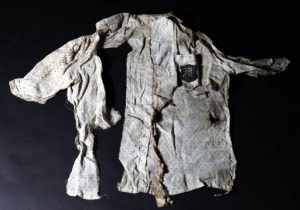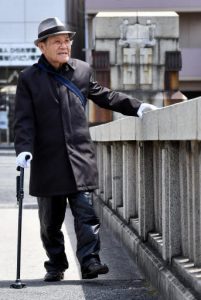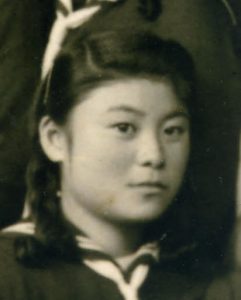17-year-old girl’s blouse scorched by A-bomb’s heat rays is displayed at Peace Memorial Museum
Apr. 24, 2019
by Junji Akechi, Staff Writer
A blouse scorched by the heat rays of the atomic bomb is said to have been fashioned by a mother for her daughter from her father’s yukata (a light summer kimono). The blouse will be put on permanent display for the first time in the main building of the Hiroshima Peace Memorial Museum, located in Naka Ward, which will reopen on April 25. Toshiko Omoto, then 17, was wearing the blouse at the time of the atomic bombing and she died in pain two months later from the burns she suffered. Her brother, Hisao Omoto, 88, who lives in the city of Hatsukaichi and donated the blouse to the museum, said that he had desperately wanted her to survive, a wish shared by his family that could not be realized.
The blouse will be displayed in the section called “Cries of the Soul,” which makes use of photos and personal belongings of A-bomb victims. On August 6, 1945, Toshiko was heading from a food factory located in Minami-machi (now part of Minami Ward), where she was mobilized as a member of the women’s volunteer corps, to the city center with several coworkers to help tear down homes to create a fire lane in the event of air raids. She was on Hijiyama Bridge, which offered no protection, when the atomic bomb was dropped on the city. At a location of 1.7 kilometers from the hypocenter, she suffered burns to her entire body and her face became unrecognizable.
Toshiko’s father, Tokuo Omoto, then 41, who experienced the atomic bombing at work, and Hisao, who was a third-year student in junior high school and was working as a mobilized student in Minaga (now part of Saeki Ward), reunited in Kabe-cho (now part of Asakita Ward), to where Hisao’s family had evacuated. On August 7, they set out to search for Toshiko and found her at a landing spot of the Army Shipping Command in Ujina on August 14. A name tag, which a soldier had attached to her, enabled them to identify Toshiko from among the many others on the ground who were severely wounded. Tokuo asked if she was indeed Toshiko, and Toshiko responded to him in a faint voice.
At the evacuation site where they brought her, Toshiko’s mother Shizuko, then 37, and Hisao cared for her, removing the maggots that festered in her wounds each day with chopsticks. Every time they reapplied “burn ointment,” a paste made from grated cucumber and wheat flour, Toshiko couldn’t help crying out in pain. Her ordeal lasted until her death on October 2.
After the war, Hisao sometimes saw the blouse, which was kept in a box made of paulownia wood. Toshiko had said, “If I continue to be part of this family, Hisao will never be able to get married. I have to die for his sake.” He often felt regret over thinking that his sister’s screams had been awful to hear while she was conveying concern about the family. His mother would often shed tears in front of the family’s Buddhist altar, and neither his father nor Hisao, who became a teacher, told other people about their experiences. In 1973, Hisao donated the blouse to the museum. He said he thought it was better not to keep the blouse at home as he hoped it could help convey the horrors of the atomic bombing and contribute to promoting peace. Still, he felt torn over this decision.
For this article, Hisao visited Hijiyama Bridge before the main building of the museum reopened. He said, “Even now, I talk to my sister in my heart and ask her what I should do when something is bothering me.” He always thinks about what life would have been like if his sister had lived. He hopes that her blouse will at least help raise people’s awareness of the atrocity of the atomic bombing.
(Originally published on April 24, 2019)
A blouse scorched by the heat rays of the atomic bomb is said to have been fashioned by a mother for her daughter from her father’s yukata (a light summer kimono). The blouse will be put on permanent display for the first time in the main building of the Hiroshima Peace Memorial Museum, located in Naka Ward, which will reopen on April 25. Toshiko Omoto, then 17, was wearing the blouse at the time of the atomic bombing and she died in pain two months later from the burns she suffered. Her brother, Hisao Omoto, 88, who lives in the city of Hatsukaichi and donated the blouse to the museum, said that he had desperately wanted her to survive, a wish shared by his family that could not be realized.
The blouse will be displayed in the section called “Cries of the Soul,” which makes use of photos and personal belongings of A-bomb victims. On August 6, 1945, Toshiko was heading from a food factory located in Minami-machi (now part of Minami Ward), where she was mobilized as a member of the women’s volunteer corps, to the city center with several coworkers to help tear down homes to create a fire lane in the event of air raids. She was on Hijiyama Bridge, which offered no protection, when the atomic bomb was dropped on the city. At a location of 1.7 kilometers from the hypocenter, she suffered burns to her entire body and her face became unrecognizable.
Toshiko’s father, Tokuo Omoto, then 41, who experienced the atomic bombing at work, and Hisao, who was a third-year student in junior high school and was working as a mobilized student in Minaga (now part of Saeki Ward), reunited in Kabe-cho (now part of Asakita Ward), to where Hisao’s family had evacuated. On August 7, they set out to search for Toshiko and found her at a landing spot of the Army Shipping Command in Ujina on August 14. A name tag, which a soldier had attached to her, enabled them to identify Toshiko from among the many others on the ground who were severely wounded. Tokuo asked if she was indeed Toshiko, and Toshiko responded to him in a faint voice.
At the evacuation site where they brought her, Toshiko’s mother Shizuko, then 37, and Hisao cared for her, removing the maggots that festered in her wounds each day with chopsticks. Every time they reapplied “burn ointment,” a paste made from grated cucumber and wheat flour, Toshiko couldn’t help crying out in pain. Her ordeal lasted until her death on October 2.
After the war, Hisao sometimes saw the blouse, which was kept in a box made of paulownia wood. Toshiko had said, “If I continue to be part of this family, Hisao will never be able to get married. I have to die for his sake.” He often felt regret over thinking that his sister’s screams had been awful to hear while she was conveying concern about the family. His mother would often shed tears in front of the family’s Buddhist altar, and neither his father nor Hisao, who became a teacher, told other people about their experiences. In 1973, Hisao donated the blouse to the museum. He said he thought it was better not to keep the blouse at home as he hoped it could help convey the horrors of the atomic bombing and contribute to promoting peace. Still, he felt torn over this decision.
For this article, Hisao visited Hijiyama Bridge before the main building of the museum reopened. He said, “Even now, I talk to my sister in my heart and ask her what I should do when something is bothering me.” He always thinks about what life would have been like if his sister had lived. He hopes that her blouse will at least help raise people’s awareness of the atrocity of the atomic bombing.
(Originally published on April 24, 2019)










